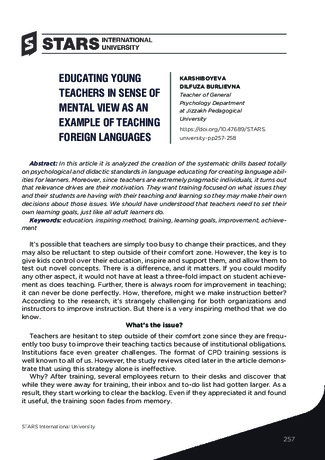
STARS International University
257
Abstract:
In this article it is analyzed the creation of the systematic drills based totally
on psychological and didactic standards in language educating for creating language abil-
ities for learners. Moreover, since teachers are extremely pragmatic individuals, it turns out
that relevance drives are their motivation. They want training focused on what issues they
and their students are having with their teaching and learning so they may make their own
decisions about those issues. We should have understood that teachers need to set their
own learning goals, just like all adult learners do.
Keywords:
education, inspiring method, training, learning goals, improvement, achieve-
ment
It’s possible that teachers are simply too busy to change their practices, and they
may also be reluctant to step outside of their comfort zone. However, the key is to
give kids control over their education, inspire and support them, and allow them to
test out novel concepts. There is a difference, and it matters. If you could modify
any other aspect, it would not have at least a three-fold impact on student achieve-
ment as does teaching. Further, there is always room for improvement in teaching;
it can never be done perfectly. How, therefore, might we make instruction better?
According to the research, it’s strangely challenging for both organizations and
instructors to improve instruction. But there is a very inspiring method that we do
know.
What’s the issue?
Teachers are hesitant to step outside of their comfort zone since they are frequ-
ently too busy to improve their teaching tactics because of institutional obligations.
Institutions face even greater challenges. The format of CPD training sessions is
well known to all of us. However, the study reviews cited later in the article demons-
trate that using this strategy alone is ineffective.
Why? After training, several employees return to their desks and discover that
while they were away for training, their inbox and to-do list had gotten larger. As a
result, they start working to clear the backlog. Even if they appreciated it and found
it useful, the training soon fades from memory.
KARSHIBOYEVA
DILFUZA BURLIEVNA
Teacher of General
Psychology Department
at Jizzakh Pedagogical
University
EDUCATING YOUNG
TEACHERS IN SENSE OF
MENTAL VIEW AS AN
EXAMPLE OF TEACHING
FOREIGN LANGUAGES
https://doi.org/10.47689/STARS.
university-pp257-258

Global dunyoda ilm-fan va ta‘limdagi innovatsion
rivojlanishning zamonaviy trendlari 15 dekabr, 2022 yil.
258
Some teachers will typically test a method out if training recommends tried-and-
true techniques for instructing and learning, and the teacher finds them appealing
and pertinent – which is not always the case. (Hooray!)
However, people discover frequently that the technique doesn’t perform as well
the first time when compared to techniques they have used for years (an unfair
comparison), so they give up on new technique. Even those who have attempted
the techniques have quickly returned to their old habits. Time was wasted on the
training.
The study demonstrates something that teachers should have understood from
the beginning: enhancing instruction is a learning process that, like all learning, calls
for:
– motivation
– a few fresh skills and knowledge
– using what you’ve learned in practice
– use of this new knowledge through trial and error improvement
– while this development is occurring, some assistance and direction from others.
Since teachers are extremely pragmatic individuals, it turns out that relevance
drives their motivation. They want training focused on what issues they and their
students are having with their teaching and learning so they may make their own
decisions about those issues. We should have understood that teachers need to set
their own learning goals, just like all adult learners do.
Therefore, it seems sense to conduct a “training needs analysis” in which teachers
are asked about the learning issues their pupils are experiencing. As an illustration:
“My students frequently struggle to compose essays”.
Used lıteratures:
1. Abós A.; Sevil J.; Sanz Mª.; García L. (2015). Variables motivacionales influyen-
tes en una Unidad Didáctica de rugby: claves para la mejora de la intervencióndo-
cente. Sportis Scientific Technical Journal, 1 (2), 110–128.
2. Carless D.R. (2003). Factors in the implementation of task-based teaching in
primary schools. System, 31 4, 485–500.
3. Deci E.L. y Ryan R.M. (1985). Intrinsic motivation and selfdetermination in hu-
man behavior. New York: Plenum.
4. Yli-Piipari S. (2011). The development of students’ physical education motivati-
on and physical activity – A 3.5-year longitudinal study across Grades 6 to 9. Tesis
doctoral, Universidad de Jyvaskyla.
5. Zimniaya I. (1992). Reproductivity and Productivity in Teaching a Foreign Lan-
guage. Foreign Languages at School, 1, 7–19.






